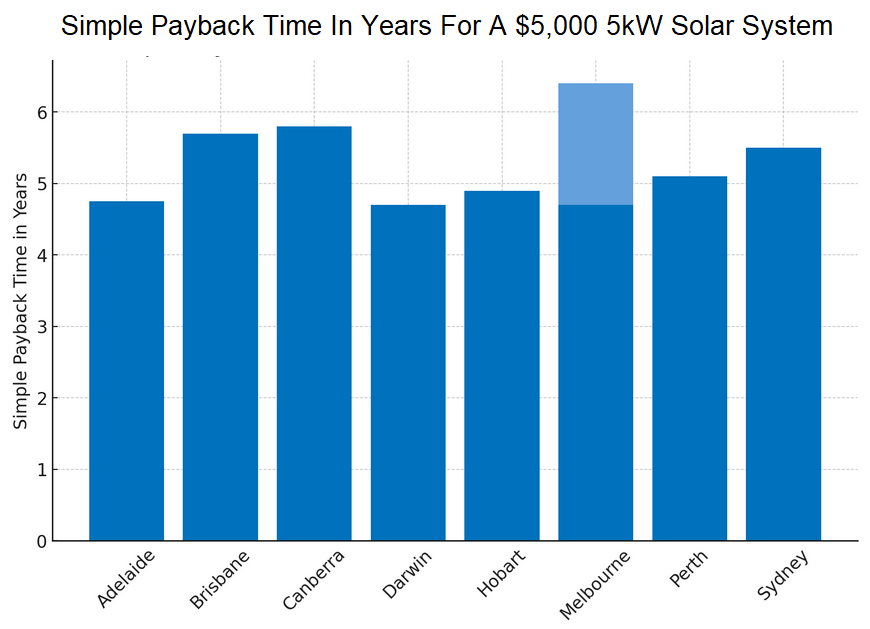Why Installing Solar On Your Investment Property Can Make As Much Sense As Putting It On Your Own Home
By Finn Peacock - Chartered Electrical Engineer, Ex-CSIRO, Founder of SolarQuotes.com.au
Last Updated: 3rd Jul 2025
Solar power has been delivering excellent returns for homeowners over the last decade and a half.
The simple payback time - the number of years it takes electricity bill savings to add up to the cost of a system - varies by location but averages around 5 years for a 5kW system:

The light blue section for Melbourne is the simple payback time if the $1,400 Solar Victoria rebate isn't used.
Because a good quality solar power system should last more than 25 years, a payback period of 5 years means that once a homeowner has broken even on their purchase, they have another 20+ years of savings to claim from a system.
With rising energy prices, this adds up to a lot!
Can Solar On an Investment Property Pay Itself Off?
But - for investment property owners, solar energy has always been a much harder sell.
This is because the core advantage of solar panels, reducing electricity bills, only benefits the person who pays the electricity bill. In most cases, this is the tenant, not the landlord.
You may have someone who says "Who cares about the financial return! By putting panels on you're saving the environment, man! Peace out!"
While this is true - it's a big ask for a landlord to outlay $5,000+ on a solar panel system out of the goodness of their hearts.
But - a study commissioned by Origin Energy showed that tenants may be willing to pay more rent for a property with solar.
It found that two-thirds of renters would be willing to pay at least $5 more a week for a property with solar panels, while 55 per cent would pay at least $10 more.
Also, a study looking at actual rents found Australians pay an average of $19 a week more for solar properties.
So if you charge an extra $10 a week rent - given that the electricity savings from even a modest sized system will normally be much more than that - the end result will be that you, as a landlord, receive extra rent and the tenant gets lower energy bills - a win-win situation.
The extra rent you collect means the simple payback of a system that costs around $5500 to install, once you factor in market-rate rent increases, will be about a decade; leaving many years of gains past that point.
If you are a landlord in Queensland, you might even get some help: The Queensland Government has just allocated funding for the Supercharged Solar For Renters scheme, offering up to $3,500 in rebates per rental property.
Solar Increases Property Value & Help Your Investment Grow
Beyond rental returns, adding solar to an investment property can also increase its market value, making it more attractive to buyers when it comes time to sell.
According to Domain’s Sustainability in Property 2024 report, solar is the leading feature of energy-efficient (EE) homes, with 43% of EE properties in Australia having solar. The report also found that:
- Energy-efficient houses sell for an average premium of 14.5% (~$112,000).
- Energy-efficient units sell for an average premium of 11.7% (~$70,000).
Buyers are increasingly prioritizing homes with lower running costs, meaning a property with solar panels will likely sell faster and at a higher price.
For investors thinking about the long-term resale value, solar can provide:
- More buyer interest – Energy-efficient homes stand out in listings.
- Faster sales – Listings for homes with solar often receive more inquiries.
- Stronger price growth – With rising electricity prices, homes that reduce energy bills will become even more valuable over time.
Every investor's best friend - depreciation
In 2025, a 6.6kW solar system costs about $6,400 fully installed (A 6.6 kW system usually has around 16 panels).
For tax and depreciation purposes, the ATO allows you to claim a 10 percent decline in system value each year using the 'diminishing value' method.
While I'm confident that a good quality, well installed solar system will last over 25 years, the ATO thinks that any given solar system's effective life will only be around 20 years.
Still - that's a long time you can claim depreciation and offset the tax payable on the additional income you can charge from putting a system on a roof.
Run the numbers and you'll be surprised
The bottom line is - solar energy is an investment that tenants are willing to pay extra for. If you are a landlord and have tenants in a property at the moment, sound them out for their opinions on paying $10 more a week in rent in return for solar being installed.
If you're looking to attract tenants or increase the overall value of your property, get quotes for solar, run the numbers around depreciation with your accountant, have a chat with your tenants, and I think you'll be pleasantly surprised about how you can come out on top.
Just hit the button below to get started:
